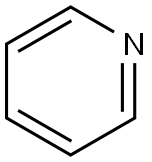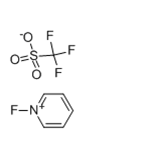Chemical Properties
white to off-white crystalline powder or needles
Uses
N-Fluoropyridinium trifluoromethanesulfonate is used as a reagent for electrophilic fluorination and for a review of electrophilic N-F fluorinating agents. It is also used as a reactant for Pd-catalyzed arylation reactions and as a fluorination agent.
Uses
N-fluoropyridinium triflate salts offer a tunable fluorinating system; electronic nature of the substituents on the ring dictates the potency and selectivity of the reagent. Efficient fluorination of various aromatics, carbanions, vinyl esters, alkyls, and enamines.
Uses
General purpose electrophilic fluorinating reagent.4
Synthesis
The round-bottomed reaction flask is charged with 4.74 g (0.06 mol) of pyridine, 10.3 g (0.06 mol) of sodium triflate, and 80 mL of dry acetonitrile. The system is purged with nitrogen, and the reaction mixture is chilled and maintained at ?40°C. The flow of dilute fluorine is started, and the flow rates from the nitrogen and fluorine cylinders are adjusted to introduce a 10% fluorine/90% nitrogen mixture at a rate of 90 mL/min just above the surface of the rapidly stirred solution. When a total of 2.7 L of fluorine (0.12 mol) is introduced, the flow of fluorine is discontinued, and nitrogen only flows through the system at a rate of 45 mL/min for 30 min while keeping the reaction mixture at ?40°C. The reaction mixture is then warmed to room temperature and filtered through a pad of Celite to remove the sodium fluoride. The filtrate is concentrated to dryness without heating with a rotary evaporator. The crystalline residue is washed with 30 mL of dry ethyl acetate to give 11.0–12.0 g (74–81%) of crude product, mp 178–181°C. The crude material is dissolved in 18 mL of dry acetonitrile at room temperature, and 36 mL of dry diethyl ether is added. The precipitated crystals are collected by filtration under nitrogen to give pure 1-Fluoropyridinium triflate.








